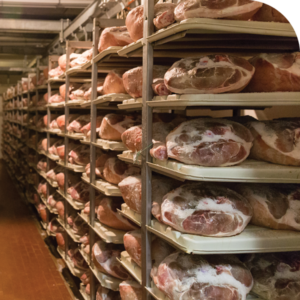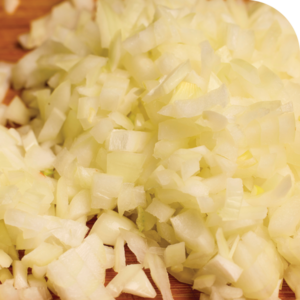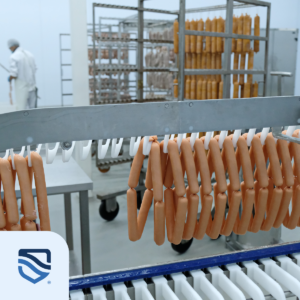As we know, food safety is the #1 priority in the food and beverage processing industry. Recent high-profile outbreaks of foodborne illnesses have highlighted the consequences of inadequate hygiene practices, leading to product recalls, reputational damage, and public health risks. As pathogens continue to threaten food processing environments, innovative air and surface purification technologies are being discussed as powerful tools that can improve these outcomes.
Pyure, a leader in food processing air purification technology, provides solutions that improve food safety by actively neutralizing airborne and surface contaminants. Let’s explore the latest challenges in food hygiene, how Pyure’s hydroxyl technology works, and the benefits of implementing these solutions in food and beverage processing facilities.
 The food processing industry faces numerous challenges in maintaining cleanliness and safety. Recent incidents, such as a listeriosis outbreak linked to unsanitary conditions in processing plants, emphasize the need for stringent hygiene measures. According to a recent article on Yale Medicine, improper sanitation of deli meats and other ready-to-eat foods has led to significant recalls, affecting both businesses and consumers. The article highlights how Listeria monocytogenes can persist in food processing environments for extended periods, often thriving in cool, damp conditions. Even after thorough cleaning, these bacteria can recolonize surfaces, posing a significant challenge for food safety managers. The CDC has warned that vulnerable populations, such as pregnant women, older adults, and those with weakened immune systems, face a higher risk of severe illness due to listeria exposure.
The food processing industry faces numerous challenges in maintaining cleanliness and safety. Recent incidents, such as a listeriosis outbreak linked to unsanitary conditions in processing plants, emphasize the need for stringent hygiene measures. According to a recent article on Yale Medicine, improper sanitation of deli meats and other ready-to-eat foods has led to significant recalls, affecting both businesses and consumers. The article highlights how Listeria monocytogenes can persist in food processing environments for extended periods, often thriving in cool, damp conditions. Even after thorough cleaning, these bacteria can recolonize surfaces, posing a significant challenge for food safety managers. The CDC has warned that vulnerable populations, such as pregnant women, older adults, and those with weakened immune systems, face a higher risk of severe illness due to listeria exposure.
Common pathogens such as Listeria monocytogenes, Salmonella, and E. coli can thrive in food processing environments, particularly where moisture and organic matter accumulate. Conventional cleaning methods, while necessary, are often insufficient in eliminating airborne threats that can settle on surfaces and food products.
 Many food processors are looking for proven alternatives, such as advanced food processing air purification technologies, to manage microbial contamination effectively. These systems offer continuous protection against pathogens, reducing the risk of contamination. Pyure’s innovative hydroxyl solution mimics the natural air-cleansing properties of the sun outdoors. By releasing hydroxyls into the environment, Pyure’s systems actively break down bacteria, spoilage organisms, mold, biofilms, and volatile organic compounds (VOCs) in food production areas.
Many food processors are looking for proven alternatives, such as advanced food processing air purification technologies, to manage microbial contamination effectively. These systems offer continuous protection against pathogens, reducing the risk of contamination. Pyure’s innovative hydroxyl solution mimics the natural air-cleansing properties of the sun outdoors. By releasing hydroxyls into the environment, Pyure’s systems actively break down bacteria, spoilage organisms, mold, biofilms, and volatile organic compounds (VOCs) in food production areas.
For a deeper dive into Pyure’s food safety solutions, visit our Food Processing Page.
Pyure’s food processing air purification technology continuously provides 24-hour protection against airborne and surface contaminants. Unlike traditional air filtration systems that trap particles, Pyure’s hydroxyl technology actively neutralizes harmful microorganisms in real-time. Studies have demonstrated that Pyure’s air purification systems can reduce microbial loads by 4-logs, significantly enhancing overall hygiene standards.

See multi-log reduction in meat processing facility.
A recent paper published by Food Safety Magazine highlights how air purification solutions can be critical to food safety strategies. Pyure’s technology has been successfully deployed in meat and beverage production plants, helping companies achieve higher safety standards and food quality, all while improving operational efficiency.
Food safety regulations continue to evolve, with organizations such as the FDA and CFIA studying the role of air purification in maintaining food hygiene. The FDA’s guidance on aseptic processing emphasizes maintaining controlled environments with appropriate air quality to prevent contamination during food production.
Similarly, the CFIA has published guidelines emphasizing the importance of air quality in food processing facilities. These guidelines advocate for the implementation of effective air filtration and purification systems to reduce airborne contaminants and minimize the risk of foodborne illnesses. While specific technologies are not mandated, the CFIA encourages the adoption of innovative solutions, such as hydroxyl-based purification systems, to enhance overall food safety protocols.
Implementing Pyure’s food processing air purification solutions helps food processors meet potential compliance requirements while reducing the likelihood of costly regulatory penalties and recalls. The industry is poised to see increased adoption of air purification technologies as part of a holistic food safety strategy. With concerns over antibiotic-resistant bacteria and new pathogen strains rising, proactive measures such as hydroxyl-based purification could become essential for food production facilities.
To learn more about how Pyure can enhance your food processing operations, visit Pyure’s Food Processing Solutions.
food quality
food safety